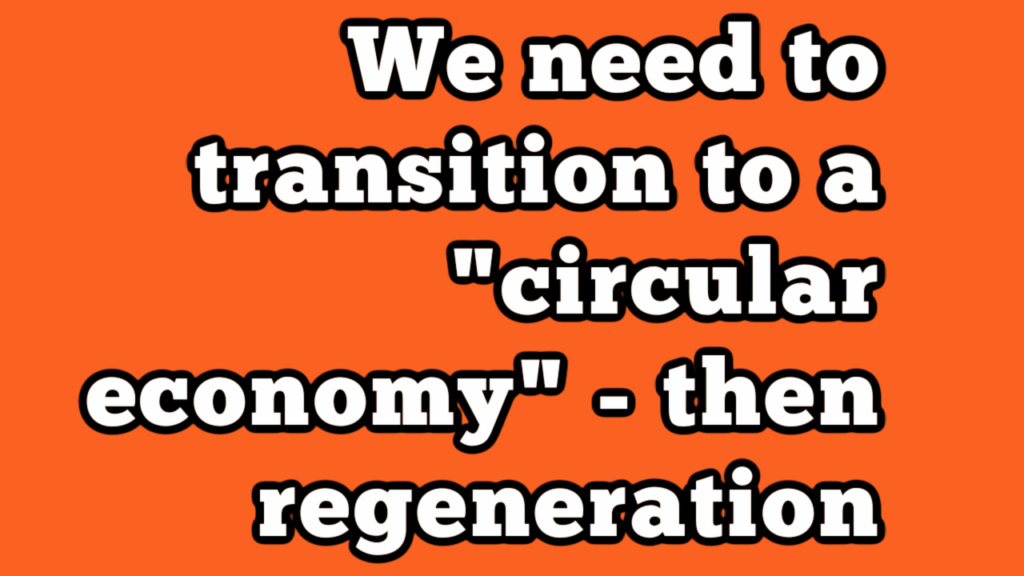We need to transition to a “circular economy” – then regeneration as the end goal

– The circular economy aims to transform the current linear economic system into one that is based on ‘designing out waste and pollution, keeping products and materials in use, and regenerating natural systems.’
– It is governed by three R’s: Reduce, Reuse and Recycle.
Here’s an article from the London School of Economics entitled: “What does the circular economy have to do with meeting climate goals?” The intro from the article states:
For an answer to the question in the title, you can look at heavy industry. Global demand for construction materials like cement and steel has risen substantially over the past decades and is expected to continue growing (International Energy Agency, 2020a). The cement and steel sectors are big energy consumers and emitters of greenhouse gases; together they account for nearly 17% of global CO2 emissions. (Assuming global CO2 emissions of 36.8 gigatonnes (Gt), cement emissions of 2.4 Gt, steel emissions of 3.7 Gt.)
They are also sectors where greenhouse gas emissions are particularly difficult to abate. The Transition Pathway Initiative showed in a recent report that only a minority of cement and steel producers are currently on track to keep the global temperature rise to below 2⁰C. Moreover, the few companies with ambitious long-term climate commitments mostly lack corresponding ambition in the shorter term. Only one out of five leading cement companies that are aligned with a 2⁰C emissions pathway in 2050 is also aligned in 2030.
Investors and regulators should be wary of backloading emissions reductions until mid-century, as it creates the risk that companies will leave themselves too much to do at the end, like a runner leaving too big a gap to the leaders to catch up and win the race. In the long term, beyond 2030, green hydrogen, low-carbon fuels and zero emissions technologies like carbon capture and storage (CCS) are likely to be key in helping cement and steel companies reduce their emissions (International Energy Agency, 2020a). But in the short term (and beyond), the concept of the circular economy offers concrete solutions to drive emissions down.
The circular economy aims to transform the current linear economic system into one that is based on ‘designing out waste and pollution, keeping products and materials in use, and regenerating natural systems’ (Ellen Macarthur Foundation). It is governed by three R’s: Reduce, Reuse and Recycle. In the construction materials sector, this approach has great potential to lower emissions by bringing together producers, intermediate manufacturers and end users, and by strengthening collaboration between sectors. A net zero future cannot be achieved if all sectors’ decarbonisation pathways remain siloed.
And here’s a note from Daniel Hires:
Circular Economy, like “sustainability”, is NOT the end goal. It’s a stepping stone to a regenerative future in which not only humans, but all life on Earth will thrive.
Finally, here’s an excerpt from this note from Rheaply’s Garry Cooper:
Principle #3: Regenerate natural systems. In combination (and in theory), the scaled effort of the above two principles should support and pave the way for the preservation of biological diversity. In our standard linear economy, we look at environmental impacts as an externality. In the circular economy, environmental benefit is baked into the very fabric of the economy.
These three principles are important, but — and this won’t be a surprise to anyone who has read previous editions of this newsletter — I don’t think these alone can put us on the path towards global circularity and sustainability. In fact, if the last five years are any indication, we’re trending in the wrong direction despite the well-intended efforts of circular-minded organizations. Despite the increase in private market funds (see figure below) with a circular economy focus (see the image below), our world is just 8.6% circular (meaning we redirect resources from the landfill just 8.6% of the time), down from 9% since this funding spike began.
